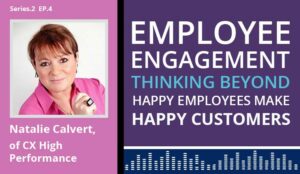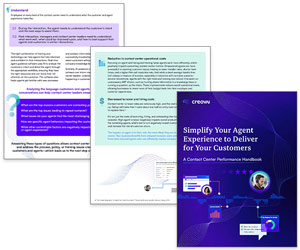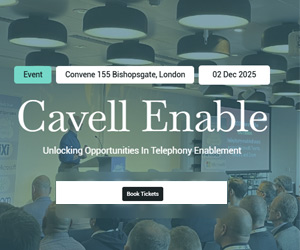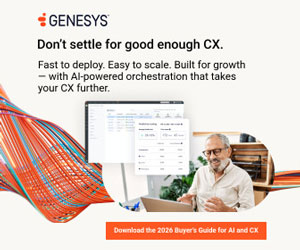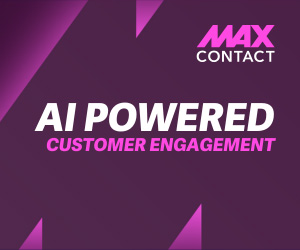Engaged, happy employees are less likely to leave, can be your best advocates, and more, so getting Employee Experience (EX) right is very important, but you can do something about it.
This article outlines ten ways to help improve employee experience and increase retention.
10 Ideas for Improving Employee Experience
Employee Experience (EX) is the foundation of this, so we asked our Consultants Panel what it takes to get EX right.
Here are the ten pillars of employee experience (EX):
1. Inspire Your Agents to Be the Best That They Can Be
Play to people’s strengths and desires and they will walk through fire for you! They will want to progress within your company, rather than looking for development opportunities elsewhere. They will also do their best work and come up with innovative ideas.
There are different ways you can inspire your agents, and this begins with knowing your agents. Discover what motivates them, dig deeper into what they want to do and what their strengths are.
This is where having a fabulous Learning and Development department that is dedicated to the contact centre can make a world of difference in making sure that your people are developed consistently.

Not only does it engage your workforce, it also starts to future-proof your business, as a happy workforce is much more likely to stay with the company and become advocates for your business.
Note – There are many agents who just want to turn up, do their job and go home. These agents need to be engaged too, so make sure you also have a conversation with them.
Contributed by: Kim Ellis, Chief Learning Architect at Go Ginger Learning Solutions
2. Create a Sense of Belonging

The sense of belonging is crucial for employees to feel connected to the company they work for, to feel like they are a part of the organization, and that their contributions are valued.
When employees feel like they belong, they are more engaged, committed, and motivated to perform their jobs at their best level. If you jump straight to demanding higher levels of productivity, or better customer service, you miss the opportunity to understand your people, and learn and grow with them.
Employees who feel valued and have a sense of belonging are more likely to go above and beyond in their work. What does it look like to create a culture of belonging?
In summary, leadership, communication, career development, work environment, and recognition and rewards all have a part to play.
Book Recommendation – Built to Win by Annette Franz
Our leadership team recently read the book, “Built to Win” by Annette Franz. This “how-to” guide to a customer-, client-, and employee-centric culture has shaped a lot of our views around the topic.
In one of the chapters, Franz explains the importance of prioritizing employee experience, as happy and engaged employees lead to satisfied customers and business success.
She recommends that companies adopt a customer-centric approach to employee experience, creating a culture where employees are empowered to deliver exceptional customer service. This means giving your employees a voice in ideas and authority in decision-making.
Contributed by: Neal Topf, President at Callzilla – The Quality-First Contact Center
3. Do Unto Employees as You Want Done Unto Your Customers
What’s happening inside the company or the organization is felt on the outside by the customer. So, what’s the employee golden rule?

Do unto employees as you want done unto your customers! You treat the people inside like you want the customer treated outside, if not even better. That’s what sets the tone for the internal culture and the employee experience.
Customer service is not a department or a strategy (although it’s part of it all); most importantly, it’s a philosophy that’s ingrained in the culture of the business.
It’s the responsibility of every employee – from the CEO to the most recently hired – to embrace the concept of customer service and realize that we have external AND internal customers.
If we don’t deal directly with the external customer, we are supporting someone or a process that is impacting the external customer.
For example, if an internal employee makes a mistake and puts the wrong tag on a bag at an airport, the customer will get to their destination airport and find that their bag is not there.
This mistake will have an impact on their fellow employees – their internal customers – because somebody else within the organization now has to take care of that to get it right.
Contributed by: Shep Hyken, Chief Amazement Officer (CAO) at Shepard Presentations LLC
4. Create an Environment That Excites People
The working environment plays a large role in how employees feel and act. Here are a few things to consider to help create a nurturing and engaging environment:
Share the Game Plan and Purpose With Everyone

Without a doubt, an environment people look forward to being in is the most important for EX.
Employees need to find joy and satisfaction in what they do; only then will they look forward to doing what they do and naturally excel at it too. It’s a no brainer.
If I work in a place where I am comfortable being myself, where I am continuously developing through challenging my abilities, and where I am allowed to do what it says on my tin, I would enjoy being there and enjoy the experience too.
So, for organizations that are looking to give their employees a great experience, start with the environment. Here’s how:
- Share the game plan and purpose with everyone.
- Point out how everyone contributes and how valuable those contributions are.
- Include employees in decision-making.
- Seek feedback.
- Trust that everyone is waking up wanting to do their best.
I’ve worked in contact centres before where the majority of take-home pay for agents was commission based, where typically the lifespan of an agent was no more than 3 years.
Yet in a call centre I worked in where the environment was one that excited people and one employees enjoyed being in, the sales agents had tenures of 10 years and more. Respect people and their roles, care for them and value them, and you cannot lose.
Contributed by: Clayton Drotsky, Director of Growth Crew Ltd
Show You CARE

This cultural transformation of “People First” and the leadership commitment to CARE will enthuse and energize people to be engaged with their colleagues, customers, and the business:
COMMUNICATE openly, transparently, interactively, and frequently any information that your people need and want to know. Listen empathetically to your people’s suggestions, concerns, and complaints. Express compassion with their recommendations and encouragement.
APPRECIATE the important roles, responsibilities, and efforts of your people.
RECOGNIZE, honour, and offer accolades for individual and team achievements, accomplishments, and acts of service to colleagues or customers.
EMPOWER people to make the right decisions for themselves, their colleagues, customers, and their business.
Contributed by: Bill Quiseng, Chief Experience Officer at billquiseng.com
5. Be Flexible in Scheduling, Remote Working and More

The number-one way to ensure a great employee experience is to offer flexibility – as much flexibility as you can possibly muster.
This is because the more the work and the job allows contact centre agents to have a life outside of work, the better they will perform at work.
Here are a couple of ways our company ensures the engagement and longevity of our employees:
- We seek their input when creating schedules to account for sleep, childcare needs, and extracurricular activities.
- We offered the flexibility of remote work long before the pandemic, finding that many employees who would otherwise call out sick would work if they could do so from home.
If you’re an ‘out of sight, out of mind’ sort of leader focus on putting the right metrics, training, quality monitoring, and systems of accountability in place and you’ll be able to extend this flexibility to your teams without the fear of them taking advantage of it.
Contributed by: Jeremy Watkin, Director of Customer Experience and Support at NumberBarn
6. Truly Listen to Your Frontline
Here’s some thinking on the difference it can make to listen and act on agent feedback:
Ask Contact Centre Agents What They Think

One of the biggest missed opportunities is not asking contact centre agents what they think. They have a unique insight into what customers want and the issues they face.
They see the failure that organizations have in meeting customers’ needs or expectations, or in the products or services being delivered. They have their ‘finger on the pulse of the customer’ and they know what the current issues are.
When I am reviewing contact centres, I always spend time with the agents. I talk to them about their roles and their experience, I listen to their calls and observe the processes and systems they use.
I observe them dealing with different channels and the tools they use. I explore the things that are not working for them and get an understanding of the difficulties that they or their customers are facing.
Yet despite having this real insight available, very few agents are ever asked about what they think or how things could be improved. It takes a short amount of time to ask, but can inspire those being asked as well as motivate them, increasing self-esteem and finding out a huge amount of insight. This investment is real engagement.
Anecdote – The CEO in the Car Park
It reminds me of the story of a CEO I once knew. He arrived at a different time each morning and parked in the car park at the point furthest from the entrance.
I walked in with him one day and asked him why he did this and he told me it enabled him to have a different conversation with a different person every morning.
He asked them how they were and what they were working on, he showed an interest. It was one of the most powerful examples of employee engagement that I have seen, and it had results!
Contributed by: Martin Jukes, Managing Director at Mpathy Plus
Believe Your Own Data

One pillar of employee experience is ‘organizational honesty’. By that I mean willingness to believe your own data and act on it.
If you are going to ask the questions, you must be ready to listen to the answers, learn from them, and make the improvements indicated. That’s the whole point.
Unfortunately, I’ve seen first-hand examples of execs who, upon reading less-than-stellar ratings, immediately start criticizing the survey and finding ways to sidestep the results.
Contributed by: Roy Atkinson, CEO and Principal Advisor at Clifton Butterfield LLC
Listen! Act on What You Learn!
The most important part of the employee experience is being asked what you think and THEN having somebody listen and act on it, as this fable helps to illustrate:
‘Frank and the Spanner: A Management Fable’
In the Midlands, there is a factory. The people who work there make bits that fit into other bits that eventually find their way into washing machines, lawnmowers and radiator valves.
It is a grimy old factory that bumps along at the bottom of the industrial supply chain, just about making enough money to keep its doors open.
The owners have tried different initiatives to improve the factory’s performance for many years, but none amounted to a whole hill of beans. The staff just bent over and rode with them; they knew nothing would change (nothing ever really changes in the Midlands) and the plant owners got progressively more and more exasperated.
The owners appointed a Bright Young Thing as the new plant supervisor to solve their productivity problem. He was fresh out of business school with the shiniest pair of shoes anybody had ever seen.
The Bright Young Thing was convinced that he knew the solution. Instead of force-feeding the staff another top-down initiative, he would get close to the work, listen to the people and understand their problems.
“You can’t transform your organization if you don’t know your organization.”
Or so he’d been taught.
Off the Bright Young Thing trotted to the shop floor, where he met Frank.
Frank was not a bright young thing. Frank had come into this world a fully paid-up member of the awkward squad; he didn’t like anyone telling him what to do, he didn’t like managers, he didn’t like productivity initiatives, and he certainly didn’t like Bright Young Things.
Bend over; here comes another one, thought Frank.
“I’m here to help you improve productivity,” said the Bright Young Thing.
“Really?” muttered Frank.
“Yes, tell me what I can do to help.”
Frank shrugged; he’d heard it before. “Nobody ever listens here,” replied Frank. “Why should I waste my time telling you what we can do to improve?”
“This time, it will be different; I will listen, I will give you what you need, and we can make this business great together.” The Bright Young Thing liked to lay it on a bit thick.
“OK,” said Frank, “Get me a new spanner.”
The B.Y.T. looked at the spanner Frank had in his hand. It wasn’t any old spanner; it was a heavyweight, chrome-vanadium, open-ended slogging spanner; they cost a pretty penny. The B.Y.T. winced. How was he going to justify buying another spanner? But he’d committed to Frank that he would listen, so off he wandered to the factory stores to see what he could do.
“Do you know how much those things cost?” gasped the head storeman.
“Is it for Frank? The old git has been angling for one of those for years; he already has a perfect spanner. You can’t trust him; if you give him another one, it will only end up on eBay. Tell him he can’t have it. Give him one, and everybody else will want one!”
So, the B.Y.T. returned to Frank empty-handed and told him the news.
“Now there is a thing,” grunted Frank. “Here you come, spouting all your engagement claptrap, I must listen to my staff, they know what to do, I must empower them, it will boost morale, blah bleeding blah blah. And what do you do about it when somebody has the guts to ask you for something?”
“What?” replied the B.Y.T.
“Bugger all!”
Frank was not a happy man.
The B.Y.T. slowly wandered off back to the storeroom. He told the storeman to hand over the spanner.
“You will have to sign for it and get it authorized!”
So, the Bright Young Thing took the chitty and walked upstairs to see the Chairman, who raised his eyebrows and eventually authorized the spanner.
Ten minutes later, the B.Y.T. was back on the shop floor, spanner in hand. He handed it over to Frank.

James Lawther
Frank took the spanner, somewhat bemused, then, with one spanner in each hand, started to adjust the motor.
Would you believe it? The machine began to run faster. Then Frank took his spanners and walked down the production line towards the next piece of equipment.
Contributed by: James Lawther, Director of Squawk Point Consulting
7. Set the Tone With a Great Leadership Team
People Don’t Leave the Company, They Leave Their Boss

The boss is a critical pillar of EX (Employee Experience). After all, ‘people don’t leave the company, they leave their boss’ is a saying that came from extensive research into high-performance teams by Gallup.
Who your boss was and is frames your points of reference for most of your career as a ‘boss’. Both good and bad, what to copy, and what to avoid. Arguably starting with parents and teachers.
Some people are naturals, but most need to learn how to be a good boss. So, designing, training towards, behaving in, and living a great culture is the key pillar of leadership (my definition of culture is ‘the way we work around here’). In turn that creates the environment for great employee experiences.
Contributed by: Peter Massey, MD & co-founder at Budd UK Ltd
Any EX Initiative Can Fail Without a Foundation of Solid Leadership
If you don’t have a great leadership team, all other aspects of employee engagement will fall short, become unsustainable, or disguise an unhealthy company culture.
This isn’t to say that professional development programmes, employee resource groups, comprehensive benefits, and adequate resources don’t matter.
They all do, and in significant ways, but they must be built on a foundation of leaders who invest in their employees’ professional, emotional, and, yes – personal – wellbeing.
Leaders set the tone for their entire organization, and employees’ engagement, accountability, and respect directly reflect what the leader puts out. It can be an uncomfortable truth to reconcile, but in my experience, only great leaders consistently yield great employees.
Here’s the real challenge with addressing this problem… Most people are blind to their leadership shortcomings or don’t recognize the unintended impacts of their actions and decisions. The only way around this is to invite other leaders to hold you accountable.
While one of these people may be your boss, you should also look to peers, mentors, or even friends, to encourage, inspire, and call you out on your strengths and weaknesses as a leader.
The point is to engage people you trust, respect, and can rely on to ensure you become the best version of yourself.
It’s to find people who help you get your attitude and perspective in the right place to engage and lead your employees well. It’s to identify the ones unafraid of telling you that you’re being stubborn, selfish, or short-sighted.

To get employee engagement right, we must get ourselves right as leaders. All too often, leaders are the last ones to spend time getting coached and developed, and yet, I believe that time spent investing in themselves is precisely the thing that’s needed to get their employee engagement levels back on track.
Contributed by: Justin Robbins, Founder & Principal Analyst at Metric Sherpa
8. Let Agents Know Their Contribution Matters
It is important to counteract the inherent negativity of a customer service job by making frontline employees feel valued. Think about it: most of an agent’s time is spent communicating with unhappy customers. All day, every day, is filled with customer negativity.
It is vital to counterbalance that negativity with internal praise. Recognize your agents’ positive impact on the overall company. Let them know their contribution MATTERS!
Here is a quick story regarding a feeling of contribution…

Two bricklayers were asked what they were doing. The first bricklayer replied they were making one wall of a building.
However, the second bricklayer said they were building a beautiful school where children can learn and grow.
Perspective is important! Do agents understand how they contribute to your organization? Do they feel their work matters? Do they feel engaged? Leaders need to create a SYSTEM for that praise and recognition.
For example, every coaching session should include some form of praise from the coach to their agent. Every team meeting should include a positive customer comment.
Every town hall meeting should include how customer experience impacts overall company performance, in areas such as client churn, upselling revenue, public perception of customer service, etc…
Make positive feedback as common as so-called “constructive feedback.”
Contributed by: Mike Aoki, President of Reflective Keynotes Inc.
9. Give Everyone the Right Tools

Most people want to do a good job and feel successful at work. This fuels self-motivation and pride.
Giving agents the right tools that help them be successful therefore positively contributes to the experience they have at work.
When contact centre agents can’t find the right information quickly to help a customer, for example, they feel that the company doesn’t care about them and how they do their job.
In addition, if agents feel that they don’t have a way to suggest improvements, this can add additional stress. These feelings can become a springboard for frustration and ultimately dissatisfaction with their work experience.
With the right technology, contact centre agents can find answers quickly, instead of scrolling through information hoping they find what they’re looking for.
Choosing the right knowledge management system, for example, that offers agents an opportunity to offer feedback right into the system and tracks how their feedback is being addressed will positively enhance their engagement.
Contributed by: Vicki Brackett, Senior Vice President – Partner Success, at livepro
10. Excel in Customer Experience (CX)
EX and CX Go Hand in Hand

The most underutilized Employee Experience pillar is Customer Experience!
Any good company knows that EX and CX go hand in hand; you can’t really have one without the other. But so few companies lean into this with the deliberate, cohesive design of the two.
In its most simple form, I’m talking about the EX–CX Loop: Happy employees create great CX – which makes for a happy customer – which in turn results in a happy employee… and so we go round and round again.
This theory is backed by data:
Companies with highly engaged workers have improved customer relations and report 20% higher sales. Engaged workers are also more present and productive, making them more likely to be attuned to the needs of customers, as well as more observant of processes, standards, and systems (reference: Gallup’s State of the American Workplace report), while companies that excel in customer experience have 1.5 times as many engaged employees (reference: Qualtrics), and CX leaders have 30% more engaged employees (reference: Temkin Group’s).
By ensuring all employees understand the overall customer experience goals and strategy, you provide a strong foundation for a more harmonious customer and employee experience.
And it’s not just statistics that tell this tale. You can see this theory in action when you look at companies that excel in both EX and CX too.
Glassdoor report that Bain & Co is the number-one (employee-ranked) best company to work for in the UK, and you’ve guessed it, Bain and Co ranks 2nd in customer loyalty with 71% of customers stating they would recommend its services.
Similarly, Glassdoor’s second-best place to work (a previous holder of the number-one spot) is ServiceNow, and at their core, they believe and demonstrate that “A great employee experience improves customer satisfaction, which helps the bottom line.”
Contributed by: Katie Stabler, Founder and Director of Customer Experience at CULTIVATE Customer Experience by Design
Deliver Simplicity

In a post-pandemic world, customers require a simple customer experience, especially when it comes to customer service.
And contact centre agents can only deliver a simple experience to customers if they’re already receiving a simple experience themselves.
Your agents are typically the front line for customers seeking assistance, and their ability to provide clear and quick resolutions is crucial to maintaining customer loyalty.
But when your agents are met with less-than-ideal resources, unclear or incomplete communications or complicated processes, they can become frustrated. Even worse? The customer becomes frustrated too.
Removing all of this friction is key to improving overall satisfaction and creating a more engaging employee experience.
So where do you start in simplifying your agents’ employee experience?
Identifying unnecessary steps in workflows and pruning them back, investing in technology to make sure it reduces friction in your agents’ experience (not creates more of it!), empowering your agents to ‘go off-script’ in difficult situations and trust them to do the right thing.
You need to ask yourself this question, “Does the employee experience we deliver help or hinder our agents in delivering an outstanding customer experience?”
If the answer is the latter, then the solution is pretty clear… Simplify your agents’ experience!
Contributed by: Matt Lyles, Keynote Speaker, Brand Consultant and Podcast Host at Matt Lyles & Co LLC
If you are looking for more great information and advice on employee experience, read these articles next:
- How to Avoid Employee Burnout
- 7 Drivers of Employee Engagement
- How to Measure Employee Engagement
- 18 Goodwill Gestures to Build Better Employee Relationships
Author: Megan Jones
Reviewed by: Jo Robinson
Published On: 5th Apr 2023 - Last modified: 24th Sep 2025
Read more about - Call Centre Management, Annette Franz, Bill Quiseng, Clayton Drotsky, Editor's Picks, Employee Engagement, Fran Fish, James Lawther, Jeremy Watkin, Justin Robbins, Katie Stabler, Kim Ellis, Leadership, Management Strategies, Martin Jukes, Matt Lyles, Mike Aoki, Neal Topf, Peter Massey, Roy Atkinson, Shep Hyken, Team Management










